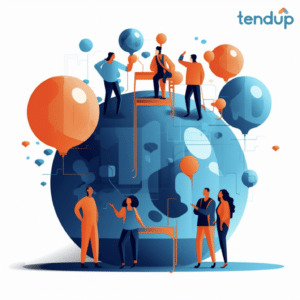Using AI for Tenders? 5 Critical Success Factors for 2025
AI is no longer just the new kid on the block. It’s already moved in, raided the fridge, and is helping write your next tender response. From faster drafts to smarter answers, AI is shaking up the way we respond to RFPs and RFTs. Gartner predicts that by 2027, 50% of procurement tasks will be automated by AI agents and this uptake is happening rapidly on both sides of procurement.
According to Accenture’s latest research, 73% of C-suite leaders believe that generative AI will fundamentally change the way their organisations operate within the next three years. This isn’t just hype. AI is now a core driver of enterprise reinvention, including how tenders and bids are managed and delivered.

But, before you hand over the keys to the robots, there are a few things you need to get sorted. Here’s what to keep in mind if you’re serious about streamlining your bids without ending up with a hot mess.
01. Your content library: it's make or break
AI tools aren’t mind readers. They’re only as good as the content you feed them. If your knowledge library is a digital junk drawer, please don’t expect magic. AI will give you ubiquitous and boring content unless you’ve incorporated your value proposition and differentiators from the outset. You’ll need to:
- Upload your best past proposals, polished boilerplate content, product info and anything else you’re willing to make publicly available. And please redact these. It’s really important in this digital age that you’re safeguarding your competitive advantage.
- Ensure that you have a bank of detailed materials (particularly case studies and capability content) that will provide enough context for adapting to a particular requirement.
- Make sure your library is up to date, organised and findable for the people in your organisation.
Think of your content library like your secret weapon. The better it is, the better your AI will perform.
The Accenture report highlights that organisations leading in AI adoption are “industrialising their data foundation”, meaning they invest in robust, well-organised content and data libraries. This foundation is what enables AI to generate high-quality, contextually relevant outputs, especially in complex processes like tendering.
02. Don't slack on data security
RFPs and RFTs often deal with confidential material that you really don’t want the competition getting their hands on – client details, personnel info, pricing, commercial strategies, much more. To safeguard your data, consider:
- Choosing AI tools with serious security creds (encryption, local hosting options, legislative compliance).
- Making sure your setup works across locations without compromising on data protection.
- If you’ve been invited to tender and are in a select group of respondents, ensure you’re clear on any restrictions on AI tool usage. There’s sensitivity, particularly with government, on putting their requirements into AI.
- Ensure you have an AI use policy drafted and that your teams are well trained on safe use.
03. AI’s smart, but you still need brains on the job
AI can speed things up, but it doesn’t replace good judgment. Human input is crucial for your tender response to stand out in evaluations.
- Nailing your bid strategy from the get-go is non-negotiable. This bit relies on humans. AI can help write, but only you can define the win themes and make sure they shine through every response.
- Have subject matter experts review and tweak outputs from AI tools. AI hallucinations are still a major headache and evaluators are getting savvy at spotting and binning tenders full of made-up fluff.
- You must ensure that your response is well mapped to requirements. AI doesn’t always do a good job of this.
04. Get better at prompting
Prompting is the secret sauce when using AI in tenders. If you want sharp, targeted responses, you’ve got to tee them up right. This is called AI orchestration – the ability to guide and refine AI outputs through iterative, context-rich prompting. A quick guide:
- Set the scene – give context: who is the client, what do they care about, what problem are we solving?
- Chunk it out – don’t throw the whole RFP at once. Work section by section, especially for the complex criteria.
- Refine as you go – if the first answer isn’t hitting it, update the prompt. Try changing the tone, length, or angle. AI loves feedback.
- Save your best prompts – once you land on ones that work, reuse and tweak. Think of it as your secret recipe book.
05. Integrate AI into your actual workflow
If your AI tool is living in a silo, it’s not doing its job. It needs to fit into your team’s existing rhythm.
- Choose tools with real-time editing, task assignment, and centralised comms.
- Make use of the readily available integrations with your current suite of applications.
- UX matters. If your AI integration is clunky, no one will use it.
AI can absolutely help you respond faster, better and with fewer headaches, but only if you set it up properly. That means clean content, human oversight, tight security and a culture that values improvement.
With Tendup in your corner, you’ll be firing off sharp, strategic proposals without the late nights or last-minute panics. We work with businesses to ensure you’re set up for bidding success. With our broad capability across bid strategy + consulting, bid management, proposal management, writing, editing and much more, we are your team of tender heroes ready to support your bid journey. Keen to hear more? Click the button below to get in touch today.


